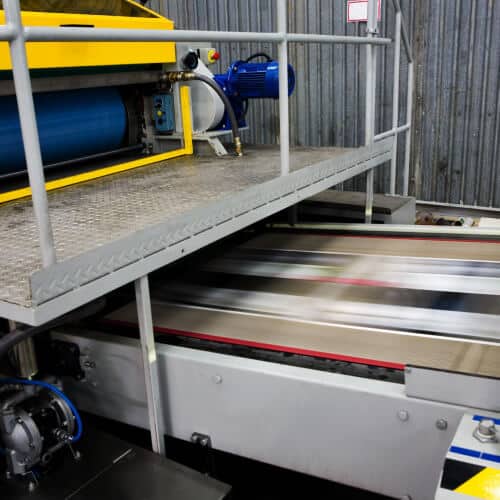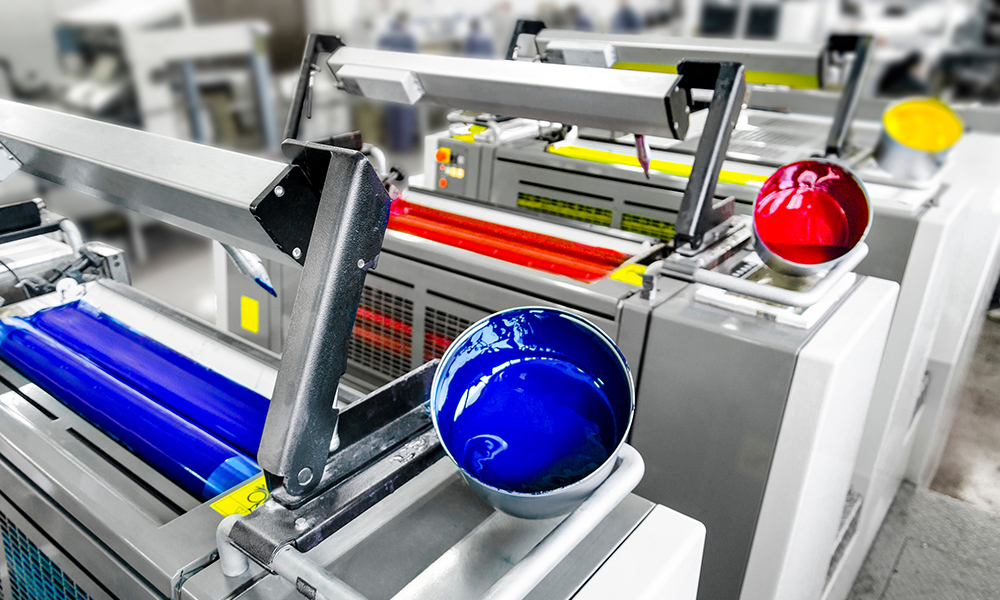How to Prepare Artwork for Optimal Results in litho printing
The Essential Overview to Recognizing Litho Printing and Its Applications
Litho printing stands as a significant technique in the printing sector, rooted in the principles of oil and water repulsion. This method not just supplies top quality photos yet likewise deals with different industrial demands. Its applications vary from advertising and marketing materials to packaging, showcasing its versatility. As the industry adapts to new innovations, the evolution of litho printing increases questions regarding its future and significance in a digital landscape. What lies ahead for this withstanding approach?

What Is Litho Printing?
Litho printing, an extensively used printing strategy, depends on the concept of oil and water repulsion. This approach utilizes a flat printing surface, typically a steel plate, which is treated to guarantee that the picture areas are responsive to oil-based inks while the non-image areas repel them. The procedure begins with the production of a picture on the plate, frequently via illustration or photo ways. Once the image is prepared, the plate is moistened with water, followed by the application of ink. The ink adheres only to the photo locations, enabling for exact reproduction of graphics and text. Litho printing is preferred for its capability to generate high-quality prints with fine information and lively colors. It is generally utilized in commercial applications, consisting of papers, publications, and product packaging, showcasing its convenience and performance in satisfying the demands of contemporary printing.
The History of Lithography
Although lithography is a modern-day printing staple, its origins map back to the late 18th century when German dramatist Alois Senefelder created the strategy in 1796. Initially established as an approach for duplicating messages and pictures, lithography utilized a flat rock surface to develop prints with a chemical process. Senefelder's technology permitted higher versatility and creative expression contrasted to previous printing methods.By the 19th century, lithography acquired extensive acceptance, coming to be a prominent choice among artists and authors. It made it possible for the mass production of pictures, maps, and posters, notably impacting the printing market. The method further advanced with the introduction of lithographic presses, improving efficiency and quality.As the commercial revolution advanced, lithography adjusted to satisfy the demands of business printing, leading the way for modern-day applications. Today, it remains an essential method in various markets, including publishing, product packaging, and fine art reproduction.
How Litho Printing Works
An essential function of litho printing is its reliance on the principle of oil and water repulsion - litho printing. In this process, photos are moved from a level surface, commonly a steel or polymer plate, to paper. Home plate is treated to make sure that the locations planned for printing attract ink, while the non-image locations repel it because of their fondness for water. The printing begins by wetting home plate with water, which adheres to the non-image areas. Consequently, an oil-based ink is used, sticking only to the desired image areas.When home plate enters into contact with the substrate, the ink is moved, creating a print. The litho printing procedure is qualified of producing premium photos with great detail. It is frequently utilized for mass manufacturing as a result of its performance and consistency, making it a favored approach for commercial printing applications
Advantages of Litho Printing
One notable benefit of litho printing is its capability to create premium pictures consistently, making it an ideal option for commercial projects. This printing technique uses a flat printing plate, making certain even ink circulation and sharp information. Litho printing is additionally renowned for its shade precision, enabling lively and true-to-life recreations, which is crucial for branding materials.Moreover, it supports a broad selection of substratums, including paper, cardboard, and also specific plastics, boosting its flexibility. The procedure is affordable for huge runs, as economic climates of range decrease per-unit prices. Furthermore, litho printing has a fast turnaround time, permitting efficient production schedules.Its durability likewise suggests that printed materials stand up to fading, ensuring that the last item maintains its visual charm with time. In general, these benefits company website make litho publishing a preferred option throughout numerous industries, contributing to its enduring appeal.
Applications of Litho Printing in Business
As companies significantly look for dependable and top notch printing remedies, litho printing becomes an essential gamer in numerous applications. This technique is particularly favored for creating advertising and marketing materials such as brochures, flyers, and directories, many thanks to its capacity to deliver dynamic colors and sharp pictures. On top of that, litho printing is often used for product packaging remedies, permitting companies to create appealing tags and boxes that boost item appeal.In the field of company identity, litho printing is instrumental in producing professional stationery, business cards, and promotional goods, which aid enhance brand name acknowledgment. It is widely used in the posting market for printed materials such as publications and publications, where constant quality is paramount. Overall, litho printing's versatility and performance make it a crucial device for companies aiming to connect properly and establish a strong market visibility.
Artistic Utilizes of Litho Printing
Litho printing functions as a functional medium in the domain name of printmaking, offering internet musicians a special method to share their imagination. This technique enables a vast array of artistic applications, from traditional prints to contemporary interpretations. By discovering the subtleties of litho printing, artists can harness its distinctive top qualities to improve their job.

Printmaking Strategies Introduction
The artistry of printmaking incorporates a diverse series of techniques, with litho printing standing out for its one-of-a-kind method to photo creation. This technique counts on the principle of oil and water repulsion, enabling musicians to draw directly onto a sedimentary rock or steel plate with a greasy medium. When prepared, home plate is moistened and inked, moving the photo onto paper through pressure. Litho printing is commemorated for its capacity to create great information and rich tonal variations, making it a preferred selection amongst artists. Furthermore, the process is functional, suiting both traditional methods and contemporary adjustments. This flexibility permits litho printing to bridge various artistic styles, enhancing the printmaking landscape with its unique features and capacities.
Unique Artistic Applications
Exploring the distinct creative applications of litho printing exposes its exceptional convenience in numerous imaginative areas. Musicians make use of litho printing to develop detailed layouts and appearances, enabling meaningful and thorough jobs. The procedure promotes the recreation of brilliant shades, making it suitable for images and great art prints. Lots of click for source modern artists embrace lithography for its ability to combine typical strategies with modern-day ideas, leading to innovative artwork. In addition, litho printing is usually used in the production of limited edition prints, boosting their worth and appeal. The tactile top quality of litho prints includes a distinct dimension, bring in collection agencies and art enthusiasts alike. Overall, litho printing continues to be a substantial medium for artistic expression, linking traditional methods with modern imagination.
The Future of Litho Printing in a Digital Globe
As the printing market develops, litho printing encounters the difficulty of integrating electronic innovations to continue to be appropriate. Techniques concentrated on digital assimilation, together with trends in sustainability and technology, will form its future - litho printing. Comprehending these characteristics is necessary for industry stakeholders seeking to adapt to a quickly changing landscape
Digital Combination Strategies
An expanding variety of litho printing business are welcoming digital assimilation strategies to remain affordable in an increasingly electronic landscape. By incorporating digital operations, these companies can enhance procedures and enhance effectiveness. This integration enables real-time information management and enhanced interaction in between departments, minimizing turn-around times considerably. Furthermore, electronic devices enable much better modification and personalization of printed materials, accommodating details customer demands. Business are additionally taking on hybrid printing services that integrate typical litho techniques with digital innovations, using convenience in manufacturing. Leveraging data analytics helps in understanding market trends and customer preferences, allowing companies to make informed choices. On the whole, electronic assimilation is becoming essential for litho printing companies aiming to introduce and react to advancing market demands.
Sustainability and Advancement Patterns

Often Asked Questions
What Materials Are Generally Utilized in Litho Printing?
The products commonly utilized in litho printing consist of aluminum plates, ink, water, and paper. Each element plays an important duty in the printing process, guaranteeing high-quality picture recreation and reliable transfer of ink onto the substrate.
Exactly How Does Litho Printing Contrast to Digital Printing?
Litho printing offers exceptional shade uniformity and quality for big runs, while electronic printing masters short runs and personalization. Each approach has distinct advantages, accommodating various demands based upon production scale and cost-efficiency.
What Is the Common Turn-around Time for Litho Printing Projects?
The normal turn-around time for litho printing tasks varies, typically ranging from a few days to a number of weeks. Variables affecting this duration include project complexity, quantity, and needed completing processes, affecting general manufacturing timetables.
Can Litho Printing Accommodate Personalized Sizes and Formats?
Litho printing can indeed accommodate custom sizes and formats, allowing for flexibility in design. This adaptability enables clients to attain unique print end results customized to their details demands, boosting the general efficiency of their jobs.
What Are the Environmental Impacts of Litho Printing?
The environmental influences of litho printing consist of source usage, chemical use, and waste generation. However, advancements in lasting techniques and green products are slowly decreasing these negative results, advertising a much more environmentally responsible strategy to printing.